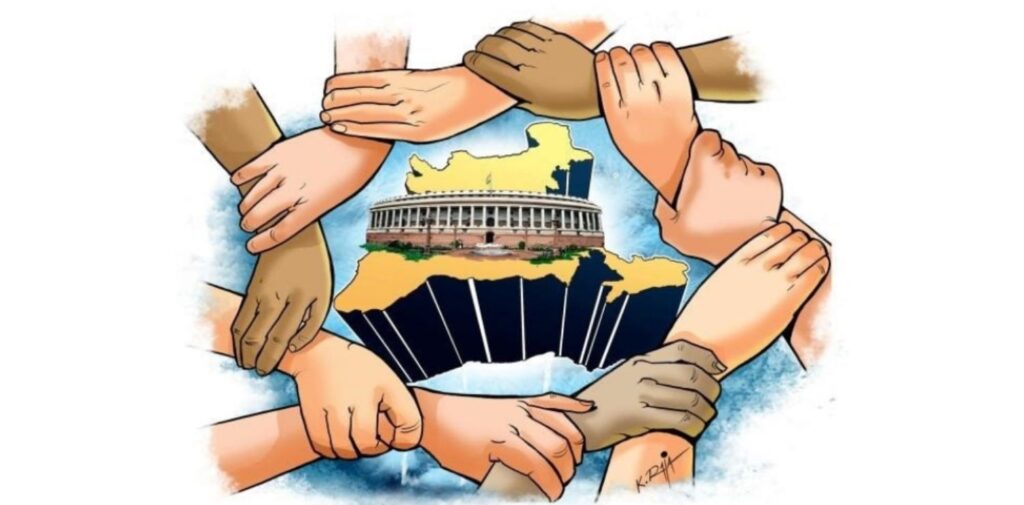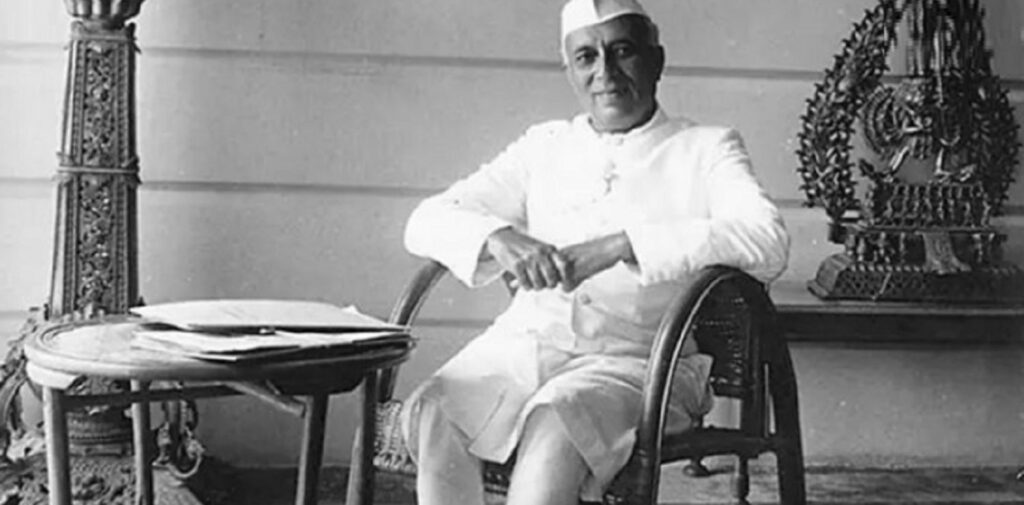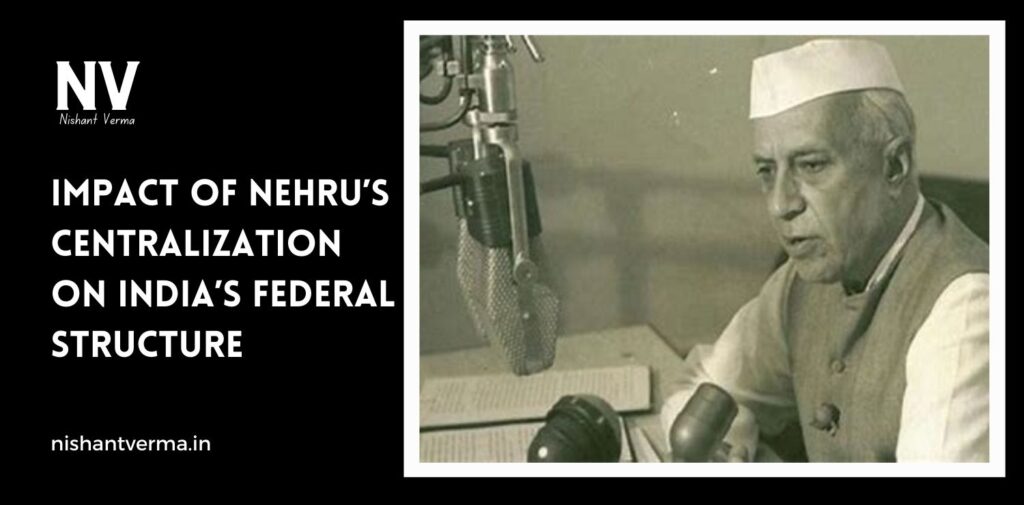India’s political system is based on a federal structure, meaning that power is divided between the central government and state governments. This division is meant to ensure that both levels of government can function independently while also working together to manage the country effectively. However, the country’s federal structure has been shaped and influenced by its history, especially during the time of its first Prime Minister, Jawaharlal Nehru. Nehru’s approach to governance, particularly his centralization of power, had a lasting impact on India’s federal system.

Understanding the Federal Structure
Before delving into Nehru’s impact, it’s important to understand what India’s federal structure is. India has a system where there is a division of power between the central government, based in Delhi, and the state governments. Each state has its own legislature and government, and they are responsible for certain matters listed in the Constitution.
This federal system was designed to balance power between the center and the states. It was inspired by the British model but also influenced by India’s unique diversity, with various languages, cultures, and religions across the country. The Constitution of India outlines this structure through three lists: the Union List (which contains subjects for the central government), the State List (which contains subjects for the state governments), and the Concurrent List (which has subjects for both).
Nehru’s Vision of India
Jawaharlal Nehru, who became India’s first Prime Minister in 1947, had a vision for a strong, unified nation. He believed that India’s diverse and vast population needed a strong central government to guide the country through its early years after independence. Nehru was deeply concerned with national integration, economic development, and modernity. He thought that a centralized system would help in achieving these goals and would allow the central government to exercise control over all aspects of governance.
During his time in power, Nehru focused on building large-scale infrastructure projects, implementing industrial policies, and promoting social reform. To achieve these, he believed that the central government needed to have significant authority over the states. Nehru was wary of the possibility of regional divisions and was convinced that strong central control would help prevent any disunity.

The Era of Centralization
Nehru’s centralization of power began soon after India gained independence. He took several steps to strengthen the central government and ensure its dominance over the states.
- Control Over Finance: One of the primary ways Nehru centralized power was through control over finances. The central government held the majority of financial resources, including taxes, and used this control to influence state governments. States became heavily dependent on the center for funds, and this dependency reduced their autonomy in decision-making. For example, the central government controlled the distribution of funds for development projects, which gave it leverage over the states.
- The Role of the Union Government: Under Nehru’s leadership, the Union Government played a dominant role in both foreign and domestic matters. This included issues like defense, foreign policy, and the economy. Nehru was keen on ensuring that the central government had authority over these critical areas to maintain the unity and progress of the country. The centralization of power in these domains reduced the role of state governments in making decisions related to national security or foreign relations.
- Planning and Development: Nehru’s emphasis on economic planning led to the establishment of centralized institutions like the Planning Commission (later replaced by NITI Aayog). This body had significant authority over how resources were allocated to various states and how development projects were planned. This system further strengthened the central government’s control, as it had the power to decide which regions received priority in terms of development and infrastructure.
- Use of Article 356: Nehru’s government also made extensive use of Article 356 of the Indian Constitution, which allowed the central government to dismiss state governments and impose President’s Rule in states where it felt that the government was not functioning properly. This gave the central government significant power to control state affairs, sometimes overriding the state’s autonomy in governance.
- The Influence of Political Parties: The dominance of the Indian National Congress (INC) at both the center and in many states during Nehru’s time also contributed to the centralization of power. Since the INC was in power both in Delhi and in several state capitals, it created a situation where the distinction between central and state governments was less clear. The party often acted as a bridge between the center and the states, which further reduced the independence of state governments.
The Drawbacks of Centralization
While Nehru’s centralization was driven by his desire for a unified and strong nation, it had several unintended consequences that affected the federal structure of India.
- Weakening State Autonomy: The most significant impact of centralization was the weakening of state autonomy. States had limited power to make decisions about their own development, and their role in the federal structure was diminished. Nehru’s control over financial resources meant that states were less able to independently manage their own budgets or initiate their own policies without the approval of the central government.
- Regional Discontent: As states became more dependent on the central government, regional leaders and politicians began to feel that their concerns were being overlooked. This led to a sense of alienation in some states, which felt that the central government did not understand or address their unique needs. The push for regional autonomy grew in many parts of India, especially in the south, where demands for greater control over local affairs were more vocal.
- Overburdening the Center: With the central government handling almost every aspect of governance, the system became overburdened. The central government had to manage not just national issues but also the day-to-day affairs of states, which led to inefficiency. Furthermore, the sheer size and diversity of India meant that one-size-fits-all policies often did not work, and regional differences were not always adequately addressed.
- Centralized Decision-Making: Nehru’s belief in a strong central government also led to centralized decision-making, where critical national decisions were made by a few leaders in Delhi without considering the opinions and needs of the states. This top-down approach sometimes led to policies that were out of touch with the realities on the ground in different regions of the country.

Nehru’s Legacy and the Changing Federal Landscape
Although Nehru’s centralization helped in building a unified nation post-independence, it also sparked debates about the need for greater decentralization in India. Over time, as new political parties emerged and regional issues gained prominence, there were calls for a more balanced federal structure.
Since Nehru’s time, India has gradually seen a shift towards greater decentralization. The 73rd and 74th Constitutional Amendments, which empowered local governments and gave them more control over local affairs, were important steps in this direction. Additionally, the rise of regional parties has led to a more competitive and less centralized political system in recent years.
Conclusion
Nehru’s centralization of power had a profound impact on India’s federal structure. While it helped maintain national unity and fostered economic development in the early years after independence, it also created challenges related to state autonomy, regional tensions, and the overburdening of the central government. As India has evolved, there has been a gradual shift towards a more decentralized system, with states gaining more authority and influence in the governance of the country. Nehru’s legacy, therefore, remains a complex one, with both positive and negative implications for India’s federalism.




